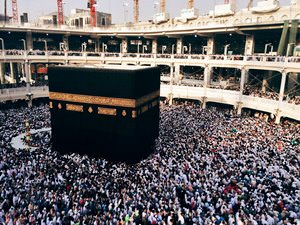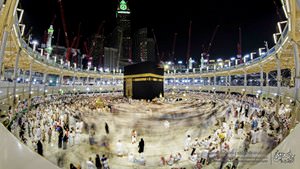 Muslim pilgrims fill Mecca in the Dhu al-Hijjah month. This is the last month of the Islamic lunar calendar. Dhu'l-Hijjah does not depend on the time of year. It is determined solely from the position of the earth's satellite. So this month can be in summer, autumn, winter or spring. It is at this time that millions of pilgrims arrive for the Hajj in Mecca. It is forbidden to harm all living things, even when it comes to plucking grass or branches; to smoke; to wear jewelry and to use incense during the pilgrimage. Men wear special clothes during Hajj. And a woman can wear the usual clothes but must keep her face and hands covered.
Muslim pilgrims fill Mecca in the Dhu al-Hijjah month. This is the last month of the Islamic lunar calendar. Dhu'l-Hijjah does not depend on the time of year. It is determined solely from the position of the earth's satellite. So this month can be in summer, autumn, winter or spring. It is at this time that millions of pilgrims arrive for the Hajj in Mecca. It is forbidden to harm all living things, even when it comes to plucking grass or branches; to smoke; to wear jewelry and to use incense during the pilgrimage. Men wear special clothes during Hajj. And a woman can wear the usual clothes but must keep her face and hands covered.
Mecca is a city of pilgrims. Everything here is connected with Muslim culture and religion. So do not expect from a trip to Mecca extreme entertainment or bright visits to nightclubs. …  Open
Open
Raffles Makkah Palace remains the most famous and prestigious hotel in Mecca. It is open in one of the skyscrapers of Abraj Al-Bait Towers. The luxurious hotel offers stylish guest rooms …  Open
Open
 The next eighth day is called Yaum at-Tarwiya. It's a thirst-quenching day. Pilgrims, who perform Hajj at this time in Mecca, massively store water. They also travel to Mount Arafat through the nearby Mina and Muzdalifah valleys. It is located twenty-five kilometers from the city. A special camp for pilgrims has been functioning for about 10 years in the Mina valley during the Hajj. It is customary to spend the night from 8 to 9 day Dhu al-Hijjah here. The so-called standing at mount Arafat takes place on a ninth day. It is considered the Central ritual of Hajj. Pilgrims not only see the sacred mountain but also pray and listen to sermons at this time. After sunset, it is prescribed to run back to the valley of Muzdalifah and pray all night.
The next eighth day is called Yaum at-Tarwiya. It's a thirst-quenching day. Pilgrims, who perform Hajj at this time in Mecca, massively store water. They also travel to Mount Arafat through the nearby Mina and Muzdalifah valleys. It is located twenty-five kilometers from the city. A special camp for pilgrims has been functioning for about 10 years in the Mina valley during the Hajj. It is customary to spend the night from 8 to 9 day Dhu al-Hijjah here. The so-called standing at mount Arafat takes place on a ninth day. It is considered the Central ritual of Hajj. Pilgrims not only see the sacred mountain but also pray and listen to sermons at this time. After sunset, it is prescribed to run back to the valley of Muzdalifah and pray all night.
Mecca is a city of pilgrims. So it is not surprising that local shops are focused on tourists. There are many large and small shops in the city. The number of stores with branded European …  Open
Open
 Here, in the valley of Mina, it is customary to bury cut hair. After that, the Hajj pilgrims return to the city. They again walk around the Kaaba, the walls of which are already covered with a new veil. Over the next three days, the pilgrims continue to offer sacrifices, return to the Mina valley and throw stones at the three pillars. All rites end on the 14th day of the Dhu al-Hijjah month. Pilgrims come out of ihram state. All ritual restrictions cease to apply to them. Now everyone who went to Hajj has the title of Hajji.
Here, in the valley of Mina, it is customary to bury cut hair. After that, the Hajj pilgrims return to the city. They again walk around the Kaaba, the walls of which are already covered with a new veil. Over the next three days, the pilgrims continue to offer sacrifices, return to the Mina valley and throw stones at the three pillars. All rites end on the 14th day of the Dhu al-Hijjah month. Pilgrims come out of ihram state. All ritual restrictions cease to apply to them. Now everyone who went to Hajj has the title of Hajji.
Numerous travelers know Mecca as the location of unique religious landmarks. This is the most frequently visited city of Saudi Arabia, and Muslim pilgrims, without a doubt, make up the …  Open
Open
National traditions of Saudi Arabia
 The man is the head of the family. He may have several wives. Religion also imposes certain restrictions on men. But their number is incomparably less than that of women. Gambling and alcohol are prohibited. The penalty for violation will be very significant. Revealing men's clothing is also not welcome. Men wear traditional closed attire. This is a long wool or silk shirt to the ankles, a handkerchief "gutra" on the head, which is attached with a cord tied around the head.
… Open
The man is the head of the family. He may have several wives. Religion also imposes certain restrictions on men. But their number is incomparably less than that of women. Gambling and alcohol are prohibited. The penalty for violation will be very significant. Revealing men's clothing is also not welcome. Men wear traditional closed attire. This is a long wool or silk shirt to the ankles, a handkerchief "gutra" on the head, which is attached with a cord tied around the head.
… Open 

